 Stimulating
Understanding of
Computational science through
Collaboration,
Exploration,
Experiment, and
Discovery for students with
Hearing
Impairments
Stimulating
Understanding of
Computational science through
Collaboration,
Exploration,
Experiment, and
Discovery for students with
Hearing
Impairments
 Stimulating
Understanding of
Computational science through
Collaboration,
Exploration,
Experiment, and
Discovery for students with
Hearing
Impairments Stimulating
Understanding of
Computational science through
Collaboration,
Exploration,
Experiment, and
Discovery for students with
Hearing
Impairments |
a collaboration of the Shodor Education Foundation, Inc., Eastern North Carolina School for the Deaf, Barton College, the National Technical Institute for the Deaf, and
Interpreters, Inc.
|
|
Search
|
For Teachers!
A note to teachers
Ohm's Law
This page walks you through the student pages "What does the model look like?" and
"What experiment can I do with the
model?"
The student questions are in
red. The answers are provided on this page in blue.
Backgournd
First, practice using your voltmeter with a flashlight battery. Be sure that you know what to expect when electricity is
flowing through the meter.
If the voltmeter pins to 0 (indicating a negative voltage) have the students reverse the wire leads. The students can sort dead batteries from new ones. Rechargeable batteries are made of different metals from regular batteries so they have a slightly different voltage. The voltage number is printed on the side of the battery.
Select two different kinds of metals. Separate them with the salt-
water paper. Both of the metals must touch the
paper. Don't let the metals touch each other. This is your battery. Connect your voltmeter the same way you did with
the battery. Record the voltage of your battery. Repeat the process with different metals.
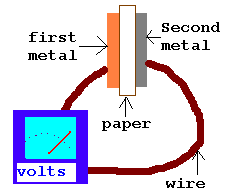
Which pairs of metals make the strongest and weakest battery?
Answers
will vary depending on the metals used. If the battery consisted of 2 examples
of the same metal i.e. steel chair and steel scissors the voltage will be approximately 0.
Were any of your batteries as strong as the flashlight battery?
Answers
will vary.
Model 1
Change the light bulb values by right clicking or control clicking the light bulb. Experiment with different values.
What values give a bright light that doesn't burn up?
Answers will vary depending on the voltage of their battery. A 3- volt battery, with a 3- watt, 3- volt bulb is bright.
Inquiry 1
Change the value of the resistance and/or battery's voltage in your circuit. Put the circuit's values into the second row on the worksheet.
Do the operations from the first row work for the second row?
If the student has the correct operations they will work for each row.
Voltage = resistance X current
resistance = voltage / current
Current
= voltage / resistance
Check the operations using several
different values. Fill out each row
with different values.
How confident are you that you have a relationship that you can depend on?
Answers will vary. Scientists have checked this relationship many times and found that metals follow this rule at normal temperatures. Nonohmic materials and even metals at exotic temperatures don't follow Ohm's Law. The usefulness of most modern electronic devices, even light bulbs, comes from how they violate Ohm's law.
Inquiry 2
Build several circuits with 2 resistors and one battery in series. Put the values into the worksheet "Ohm's Law with 2 resistors in series". Replace the ? between voltage and current with the operation you discovered in the first worksheet. Replace the ? between the resistors with + - / or X to make the statement true.
In a series circuit with 2 resistors, do you add, subtract, multiply or divide the resistors?
Add.
Does the same operation work if you have 3, 4 or more resistors connected in series?
Yes; by adding the resistances together you get the total
resistance. Putting that into Ohm's Law you get the current for the circuit. The
voltage for the entire circuit can also be found this way. The voltage or
potential difference on either side of a resistor can be calculated using the
circuit's current and the resistor in question, as seen below.
What happens if you have 2 batteries in the loop? Can you find a way to make Ohm's Law work for this circuit?

Build several circuits with 2 batteries and one resistor in series. Put the values into the worksheet "Ohm's Law with 2 batteries in series". Replace the ? between resistance and current with the operation you discovered in the first worksheet. Replace the ? between the voltages with + - / or X to make the statement true.
In a series circuit with 2 batteries, do you add, subtract, multiply or divide the voltages?
Add
Does the same operation work if you have 3, 4 or more batteries connected in series?
Yes
Does the same operation work if you have 3, 4 or more batteries connected in series with resistors between them?
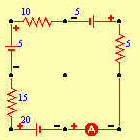
Yes,
if you are considering the total voltage resistance and current. The voltage
will vary across different points in the circuit.
Is the current the same or different at different places in a circuit with several resistors and batteries?
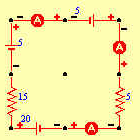
It is the same
From Ohm's Law we can calculate that .3 amperes of current is flowing through the following circuit. Check the results to verify the value.

This current is flowing through all 3 resistors. Use the equation, voltage = resistance ? current with the ? replaced, to calculate the voltage across each of the resistors. Replace .3 amperes for the current and 10 ohms for the resistor. Repeat this using 20 ohms for the other resistor.
The 10 ohm resistors have 3 volts across them and the 20
ohm resistor has 6 volts across it. 3 + 3 + 6 = 12 volts across all 3 resistors.
Check your calculations by inserting a voltmeter in the circuit. Check the voltage for each of the 3 resistors.
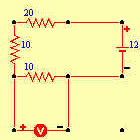
By using Ohm's Law you can calculate the current and voltage anywhere in a series circuit.
What happens if the circuit isn't a series circuit? What if there is more than one path that the electricity can flow through? The next page will help you
explore this situation.
Inquiry 3
Construct this circuit with the Circuit Builder model. Remember to set the internal resistors for the components to 0. This will allow you to examine the ideal
condition.
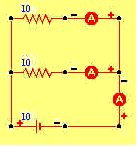
What are the 3 current readings?
The current going through each 10 ohm resistor is 1 amp
(horizontal ampere meters). The current returning to the battery is 2 amps
(vertical ampere meter).
Explain these current values in terms of the voltages across the resistors.
The voltage across each resistor is 10 volts. Using Ohm's
Law Current = V/R or 10/10=1 amp. Each of the one amps that passed through the
resistors combined to pass through the vertical wire or 2 amps.
Change the resistor values in the parallel circuit. Calculate the new currents for your circuit.
Check your results using the Circuit Builder model.
Answers will vary.
Propose a rule to help you apply Ohm's Law to parallel circuits.
Answers will vary. One can calculate the current passing
through a resistor if the voltage across it can be found. The total current =
the sum of the currents for all of the paths that the electricity passes
through.
Check your rule by constructing several parallel circuits with different numbers of resistors and different strength resistors.
Answers will vary.
Circuits can have both parallel and series components.
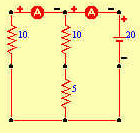
Calculate the current in this circuit. Use the Circuit Builder model to check your answer.
2 amps goes through the 10 ohm left resistor. 3.3333 amps
returns to the battery.
Propose a rule to help you apply Ohm's Law to parallel circuits that have series sections in them.
Treat the series section as a series circuit. Take
the voltage across the section and divide it by the sum of the resistors
in the section to find the current passing through it.
Check your rule by constructing several parallel circuits with sections containing several resistors.
Answers will vary.
Predict the effect of putting two batteries in parallel.
The batteries will last longer but the voltage will be the same as you would have with only one battery. If the batteries are of different voltages, the lower voltage battery will get recharged.
 The Shodor
Education Foundation, Inc.
The Shodor
Education Foundation, Inc.
Copyright © 1999-2001 by The Shodor Education Foundation, Inc.
|
by the National Science FoundationOpinions expressed are those of the authorsand not necessarily those of the National Science Foundation. |

|